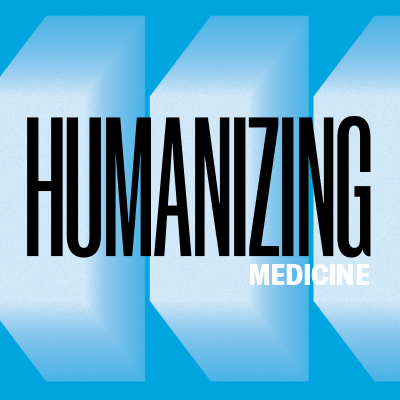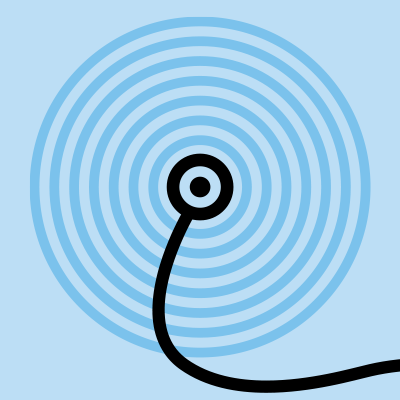
For Scott Wright, a 2 p.m. meeting every Wednesday is among his favorite hours of the work week. That’s when he gathers with the other five members of the CLOSLER.ORG editorial team to refine takeaways from articles that have been contributed by clinicians from all over the world — valuable reflections and insights on how best to provide exceptional care to patients.
The CLOSLER site, launched in 2018 by CIM’s Miller Coulson Academy of Clinical Excellence to bring today’s doctors “closer to Osler,” has really taken off in its first six years.
“We now have thousands of health care professionals and trainees from all over the world — doctors, nurses, medical students, trainees, pharmacists and more — who are regularly visiting CLOSLER and learning about how best to serve patients and work more effectively across clinical settings,” says Wright, director of the Miller Coulson Academy and holder of The Anne Gaines and G. Thomas Miller Professorship.
He notes that CLOSLER’s content is shared beyond the website to those who subscribe to the site’s weekly email (more than 10,000 individuals) and with many more people across numerous social media platforms, including Twitter/X, Instagram, TikTok, LinkedIn and Facebook.
“It’s really been a joy to see CLOSLER expand and evolve, as it has made the Johns Hopkins name synonymous with clinical excellence.” – Scott Wright
CLOSLER has also seen additions to its offerings beyond the typical clinical care articles that are a mainstay. In response to increasing interest in the humanities in medicine, the editorial team launched a new forum for “creative arts in medicine” that has quickly gained a following. In one recent entry, Hopkins internist Sujay Pathak performed a song he had created, “Heal Me,” which was inspired by an end-stage patient with heart failure.
Says Wright, “It’s really been a joy to see CLOSLER expand and evolve, as it has made the Johns Hopkins name synonymous with clinical excellence.” He adds, “I can’t wait to see what the future will hold as we grow in our mission to inspire clinicians the world over to provide more humanistic and clinically excellent care.”
Don Willett October 30th, 2024
Posted In:
 There is a CIM-led revolution brewing across the Johns Hopkins Medicine enterprise — one that is forward-looking while also steeped in history, namely William Osler’s guiding ethos: “The good physician treats the disease; the great physician treats the patient who has the disease.”
There is a CIM-led revolution brewing across the Johns Hopkins Medicine enterprise — one that is forward-looking while also steeped in history, namely William Osler’s guiding ethos: “The good physician treats the disease; the great physician treats the patient who has the disease.”
The importance of getting to know patients as people has been a pillar of CIM’s mission since its founding 20 years ago, perhaps most notably through the establishment of the Aliki Initiative in 2007, which created a new model for the way young doctors should be trained.
Today — with patients increasingly feeling dehumanized in the face of rapid technological advances and with doctors experiencing burnout at unparalleled rates — it is more crucial than ever to focus on the Oslerian tradition. Enter, CIM’s Initiative for Humanizing Medicine (IHM), an ambitious, institution-wide effort launched in fall 2022 that aims to make Johns Hopkins nothing less than the national model for humanized health care.
To do that, IHM’s leaders are starting close to home. “In our first two years, we have been working hard to identify clinicians across our schools of medicine, public health, nursing and other divisions who are committed to the values and the vision of the Initiative for Humanizing Medicine — that is, to ensure that every patient is treated with dignity and respect and gets compassionate care,” says IHM Co-Director Mary Catherine Beach, a professor of medicine and Mary Gallo CIM Scholar.
“We’ve been planting seeds and establishing fertile soil so that humanized medicine can take further root and sprout up across all of Johns Hopkins Medicine.” – Scott Wright
IHM Co-Director Scott Wright likes to use a gardening metaphor to describe the far-reaching effort underway. “We’ve been planting seeds and establishing fertile soil so that humanized medicine can take further root and sprout up across all of Johns Hopkins Medicine,” says Wright, Mary Gallo CIM Scholar, director of CIM’s Miller Coulson Academy of Clinical Excellenceand holder of the Anne Gaines and G. Thomas Miller Professorship.
Beginning with a kickoff half-day retreat at Folly Farm, the home of Stephanie and Erwin Greenberg, which drew more than 50 clinician leaders from across Johns Hopkins in September 2022 (and again in 2023) to brainstorm about potential collaborations, IHM leaders have convened quarterly dinners on different campuses where like-minded participants can catch up, bond, and discuss opportunities and initiatives.
“By convening regularly, we aim to gather ideas and guide and help participants so they can be agents of change within their own clinical areas,” says Wright.
“By convening regularly, we aim to gather ideas and guide and help participants so they can be agents of change within their own clinical areas.” – Scott Wright
Already, through a series of “microgrants,” IHM leaders have funded 14 projects initiated by teams across Johns Hopkins — many led by nurses — that are dedicated to making changes aimed at improving the patient experience. Martha Abshire Saylor, the Mary Ousley CIM Scholar and the first CIM nurse scholar, who is co-leading the microgrants program with Beach and Wright, notes that they received close to 100 creative proposals from across Johns Hopkins.
In one, radiation oncologist Annie LaVigne is working with journalist Elizabeth Tracey, who is also a chaplain at The Johns Hopkins Hospital, who in 2020 launched “This Is My Story,” a two-minute audio clip that includes lots of personal details about a patient based on interviews with patients and family. The recorded files are attached to the electronic medical records of patients to give doctors and nurses a picture of the patient’s individual story.
“We have been working to not only expand TIMS, over to my domain in the cancer center,” says LaVigne, “but to truly push forward the notion of having a ‘Personomics’ tab in the electronic medical record, which would ideally incorporate the ‘personal snapshot’ that I had envisioned.” That snapshot aims to “amplify the patient voice,” she says, by integrating patient-centered audio, visual and written components within the electronic medical record.
IHM leaders have also funded five larger research grants — chosen from among 46 proposals — through which faculty/student/staff teams are working creatively to lay the groundwork for substantive improvement in humanized care. In one project, a team is exploring the role that storytelling takes when patients are awake for surgical procedures. In another, which is ultimately aimed at alleviating burnout and increasing empathy in early-career ICU providers, a research team is recording and analyzing video interviews with ICU patients and their caregivers.
“We want to help participants build a career within this discipline of humanized medicine and take the field even further.” – Mary Catherine Beach
“In addition to providing funding of up to $25,000 for each project, we are actively mentoring these research teams,” says Beach. “We want to help participants build a career within this discipline of humanized medicine and take the field even further.”
An Impact Impossible to Estimate
The groundwork for the Initiative for Humanizing Medicine was laid in the early years of CIM through the Aliki Initiative, named for funder Aliki Perroti.
Janet Record was a chief medical resident at Hopkins Bayview Medical Center when the Aliki Initiative was launched in 2007. Record’s experience helping to design and implement this patient-centered care curriculum was so formative that she has focused her career on advancing its central tenets among today’s trainees through her curriculum building, clinical teaching and published research. “I was so lucky to be at the right place at the right time, to have this chance to help build and sustain the Aliki program,” says Record, today co-president of the national Society of Bedside Medicine, launched in 2016 by Brian Garibaldi, the Douglas Carroll, MD CIM Scholar.
While the Aliki curriculum has evolved over the years, its foundational pillars remain intact. It begins at patient admission, with residents being trained to ask a series of questions “that make a big difference in providing humanistic, patient-centered care,” Record says. Questions go beyond simply asking about what medication a patient takes, to exploring what concerns a patient may have about their medications, such as cost, regimen complexity, side effects or other barriers to taking prescribed medications. In a series of prompts now built into the electronic medical record, trainees on the Aliki service also ask about life outside the hospital, such as, “What is a typical day like for you? Who lives with you? What is most important to you?” Record explains.
Other important Aliki elements include spending a greater balance of time at the patient bedside rather than the conference room during medical rounds, where patients can hear and participate in more of the discussions, and clinical skills can be fostered at the bedside; communicating with a patient’s outpatient clinicians; and following up with patients after they are discharged.
“The Aliki experience will go with me in all walks of my professional life. It has a direct influence on me as the chair of our hospitalist group … [and] I also find myself drawing from my Aliki experience in most patient encounters.” – Colleen Christmas
Surveys of trainee participants conducted by Record and her Hopkins colleagues have found that residents who participate in the Aliki program are indelibly impacted. “The Aliki experience will go with me in all walks of my professional life. It has a direct influence on me as the chair of our hospitalist group … [and] I also find myself drawing from my Aliki experience in most patient encounters,” noted one participant in a 2020 study led by Colleen Christmas and Record published in the Journal of Graduate Medical Education. “During busy days with numerous encounters, my training helps me to keep the patient at the center. It reminds me that I am dealing with an individual (a father, a husband, or brother), and not just an ‘n’ in a randomized controlled trial,” observed another.
Each year, about 60 medical residents cycle through the Aliki rotation. They then carry what they learn to all other experiences, including the other general medical services and intensive care units, notes Vice Dean for Education Roy Ziegelstein, the Sarah Miller Coulson and Frank L. Coulson, Jr. Professor of Medicine.
“Because the graduates who leave our residency programs take with them what they’ve learned to other institutions and practice settings, the true number of patients impacted over these past 16 years is almost impossible to estimate,” he says.
“It is estimated that since the inception of the Aliki Service, residents trained on Aliki have — during and after their training — touched the lives of nearly 1 million patients.” – David Hellmann
“It is estimated that since the inception of the Aliki Service, residents trained on Aliki have — during and after their training — touched the lives of nearly 1 million patients,” notes CIM Director David Hellmann.
In his book Let Me Heal: The Opportunity to Preserve Excellence in American Medical Education, noted medical historian Kenneth Ludmerer, M.D. ’73, highlighted the Aliki Initiative as a model for fixing graduate medical training. As Ludmerer has written: “The Aliki Initiative is the most important innovation in graduate medical education in a generation.”
A Demand for Change
While the patient-centered focus of the Aliki Initiative has primarily been on early-career physician trainees, the Initiative for Humanizing Medicine is casting a wider, institution-wide net, “creating a connective tissue across Johns Hopkins that will allow us to rebuild the health care system and make Johns Hopkins a model for the world,” says Cynthia Rand, senior associate dean for faculty and Mary Gallo CIM Scholar, who co-led the Aliki Initiative.
While the Initiative for Humanizing Medicine is still in its early years, its work has already earned significant financial support through more than $11 million over the next five years in grants (primarily from the NIH and CIM supporter Mary Gallo) supporting multidisciplinary projects spanning the schools of medicine, nursing, public health and business. Most of those projects are led by Beach, who is renowned for her research on improving doctor/patient communication and ensuring respect for all patients.
“If we can create a place where people come together and think about what needs to change, they will demand more from our health system. This could be a revolution.” – Mary Catherine Beach
Over the course of just the past year, Beach has published 17 manuscripts in peer-reviewed journals, submitted three new grants for funding, and has worked extensively in mentoring postdoctoral fellows, medical students and junior faculty on projects related to humanizing medicine. Most recently, she and an interdisciplinary Hopkins team received a prestigious 2024 Discovery Grant from the university for their research project “The Dynamics of Trust: An Interdisciplinary Approach to Improving Health Care.”
Says Beach, “If we can create a place where people come together and think about what needs to change, they will demand more from our health system. This could be a revolution.”
“CIM has invested in people and good ideas — but primarily in people. That has allowed Johns Hopkins to retain really talented, ethical, wonderful people to practice medicine in a more relaxed manner and to support their desire to educate the next generation of physicians to be more humanistic. What makes Hopkins great is the people. CIM has been crucial to keeping great people.” – Mary Catherine Beach, Co-Director, CIM’s Initiative for Humanizing Medicine
“Every time I go to a CIM retreat or a small group gathering, I think, ‘This is what it means to be a physician. To be somebody who sees themselves as a healer and part of a wonderful tradition.’ CIM puts me in a room — or sometimes, literally a field, as when we meet at Folly Farms — with other people who see medicine truly as a healing art, profession and a calling.” – Jessica Bienstock, Director of Graduate Education
Don Willett October 30th, 2024
Posted In:

It’s been more than a year since Josh suffered severe burns from a gasoline fire that ultimately brought him to the Burn Center at Johns Hopkins Bayview Medical Center for reconstructive surgery. While the toughest part of his recovery is behind him, the young adult carries scars on his neck and arms that have given him a new way of looking at life.
Josh recently shared his perspectives with two plastic and reconstructive surgery residents at Johns Hopkins — Cecil Qiu and Patrick Keller — in a powerful conversation and photo session. “His experience has given him a whole new perspective in his interactions with family members and co-workers,” says Qiu. “How they respond to him, Josh told us, offers him real insight into their character.”
Qiu and Keller plan to publish Josh’s account, with that of other Johns Hopkins patients they interview and photograph, in an online forum. The young doctors’ goal? To capture individuals’ “moments of hope, unforeseen challenges and the transformative experience of reconstructive surgery.”
The undertaking is just one of nearly a dozen “Personomics Projects” that have been funded through the Barbara and Peter K. Miller Scholars Personomics Initiative, part of CIM’s Initiative for Humanizing Medicine.
“Personomics” is a term first coined by Johns Hopkins cardiologist Roy Ziegelstein in a widely cited editorial in Journal of the American Medical Association, which launched a powerful movement at Hopkins — and beyond (see box). The central premise? In the rush to embrace the high-tech advances of precision medicine, “patients can wind up feeling left out, and that’s not what doctors want,” says Ziegelstein, a Miller Coulson master clinician and the Sarah Miller Coulson and Frank L. Coulson, Jr. Professor of Medicine. Personomics is aimed at refocusing clinicians’ attention on the unique life experiences of individual patients.
The first round of Personomics Projects, selected for funding in late 2022 and now in full swing, run the gamut — from two dermatology residents who are investigating the factors that lead patients to miss their appointments to the implementation of a “personal snapshot” to the electronic medical record, a project led by radiation oncologist Annie LaVigne, who is joining forces with journalist/chaplain Elizabeth Tracey.
“I think our discovery of this shared vision and one another has been the greatest impact of our Personomics grant.” – Annie LaVigne
Says LaVigne, “I think our discovery of this shared vision and one another has been the greatest impact of our Personomics grant.”
Don Willett October 30th, 2024
Posted In:
 Over the 21 years of the annual Miller Lecture, the speakers have varied — from authors to physicians, from poets to economists — but all have touched on a common theme: the crucial importance humanism holds for health and medicine.
Over the 21 years of the annual Miller Lecture, the speakers have varied — from authors to physicians, from poets to economists — but all have touched on a common theme: the crucial importance humanism holds for health and medicine.
“I was in the process of laying out plans for my new book, which would become a cultural history of the treatment and healing of mental suffering, when I gave the 2017 Miller Lecture,” says renowned Hopkins psychologist Kay Redfield Jamison. “In ‘Healing the Mind: Writing Takes the Ache Away,’ I talked about the nature of being human and what it means to heal. The audience of physicians, trainees and CIM friends was engaged and had many great questions.”
Indeed, since the very first Miller lecture in 2004, hundreds have turned out each May to soak up the inspirational wisdom of speakers like Susan Magsamen, founder and executive director of the International Arts + Mind Lab, who presented, “Your Brain on Art: How the Arts Transform Us.”
“The Miller Lecture began in 2004 in the learning environment of the Department of Medicine Grand Rounds with lectures focused on clinical excellence and the holistic role physicians play in improving the lives of their patients.” – David Hellmann
“The Miller Lecture began in 2004 in the learning environment of the Department of Medicine Grand Rounds with lectures focused on clinical excellence and the holistic role physicians play in improving the lives of their patients,” explains CIM Director David Hellmann. The impactful series would not be possible, he emphasizes, without the generosity of the Miller family — the late Mr. G. Thomas Miller and Mrs. Anne G. Miller, and their daughters and sons-in-law, Mrs. Sarah Miller Coulson and the late Mr. Frank L. Coulson Jr. and Mrs. Leslie Anne Miller and Mr. Richard Brown Worley.
Hellmann himself gave a Miller Lecture in May 2020, “Bayview: Johns Hopkins’ Ode to Joy,” with insightful remarks that were enriched by a string trio of Hopkins physicians who captured Hopkins’ tripartite mission: the strand of caring (oncologist/cellist Matthias Holdhoff); the innovative strand of science (then-resident Bela Turk on viola) and the strand of justice related to health (endocrinologist/violinist Nestoras Mathioudakis).
During the musicians’ performances, which culminated in Beethoven’s stirring “Ode to Joy,” Hellmann encouraged the audience to reflect on caring, science and justice in health — and how powerful they are together in making medicine a better public trust.
Don Willett October 30th, 2024
Posted In:
 Across the Johns Hopkins Medicine enterprise, there are many, many clinicians — doctors, nurses, social workers and more — who are dedicated to getting to know their patients as people. And these clinicians are eager to do everything they can to improve the lives of their patients.
Across the Johns Hopkins Medicine enterprise, there are many, many clinicians — doctors, nurses, social workers and more — who are dedicated to getting to know their patients as people. And these clinicians are eager to do everything they can to improve the lives of their patients.
That was the realization that struck Martha Abshire Saylor, the Mary Ousley CIM Scholar and the first CIM nurse scholar, when she and colleagues Scott Wright and Mary Catherine Beach put out a request for proposals in early 2024 for ideas aimed at humanizing the patient experience.
“Through this new microgrants program, we received close to 100 proposals from teams all across The Johns Hopkins Hospital, Bayview Medical Center and Suburban Hospital,” says Abshire Saylor. “Many proposals were spearheaded by nurses, whose entire mission it is to treat the whole patient, and many came out of specialties that are dedicated to getting to know patients as people — such as pediatrics, psychiatry, palliative care and women’s health.”
“Through this new microgrants program, we received close to 100 proposals from teams all across The Johns Hopkins Hospital, Bayview Medical Center and Suburban Hospital.” – Abshire Saylor
The microgrants program is among the first outreach efforts of CIM’s new Initiative for Humanizing Medicine (IHM). And already, the program has gone a long way in starting conversations and inspiring collaborations among people who might not otherwise have ever met to share ideas and dreams for improving care for their patients, says Abshire Saylor.
Ultimately, 14 projects were chosen to receive grants of $1,500, and the selected teams are now busy putting their plans into action. One team led by psychiatrist Idris Leppla, for example, is equipping patient safety attendants to use activity boxes to help keep delirious patients engaged. Another project is providing professional-quality photos of infants in the pediatric cardiac ICU soon after their birth and prior to heart surgery.
The microgrants program was inspired by the earlier success of CIM’s “pyramid grants” program, launched in 2011, which Cynthia Rand — the Mary Gallo CIM Scholar (2022) and an active member of the Initiative for Humanizing Medicine — oversaw at Bayview.
Don Willett October 30th, 2024
Posted In: